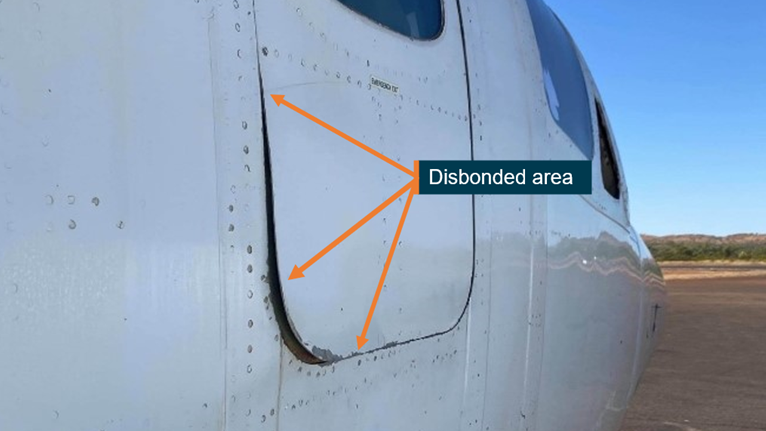
An Australian Transport Safety Bureau (ATSB) investigation into a depressurisation incident involving a Cessna 441 Conquest has resulted in a new ultrasonic bond inspection procedure for the aircraft’s emergency exit door.
During a 22 July 2020 charter flight from Broome to Browns Range, Western Australia, with two pilots and six passengers on board, a Skippers Aviation operated Cessna 441 experienced a rapid depressurisation shortly after reaching its planned cruising altitude of flight level 270 (approximately 27,000 ft). In response the pilots and passengers donned their oxygen masks and the pilots performed an emergency descent.
When at 10,000 feet, the pilots removed their oxygen masks, instructed the passengers to do the same and confirmed they were all responsive and uninjured. After communications with the operator’s senior base pilot, the pilots continued their flight with the aircraft depressurised to Browns Range, where the aircraft landed without further incident.
During their walk-around of the aircraft both pilots noticed the lower aft section of the emergency exit door skin had disbonded.
“A structural fatigue investigation concluded that the emergency exit door progressively disbonded between the inner and outer skin, likely due to the age of the aircraft, facilitated by a combination of corrosion, moisture, and flight cycles,” said ATSB Director Transport Safety Dr Stuart Godley.
“This weakened the structure, which resulted in an accelerated failure of the bondline and rapid depressurisation of the cabin when the aircraft reached flight level 270.”
The incident aircraft was manufactured in 1978 and had accumulated over 27,000 flight hours and was operating under a supplementary type certificate (STC) life extension program developed by West Star Aviation. As a result of this incident and the subsequent discovery of two further disbonded doors in two other Cessna 441s operating under the life extension STC, it was concluded that the STC’s existing visual inspection procedures for the emergency exit door bondline were inadequate.
In January 2021 Textron Aviation (the type certificate holder for Cessna aircraft) released a service letter for the Model 441 Conquest/Conquest II introducing an ultrasonic bond inspection of the the aircraft’s emergency exit door to verify the integrity of the emergency exit door bondline.
Separately, the operator is seeking a design advice response from the Civil Aviation Safey Authority for the modification of its Conquest aircraft with the installation of rivets through the bondline and subjecting the door to additional inspection requirements.
The investigation also notes that the incident aircraft returned to Broome with the pilots applying the minimum equipment list for the pressurisation system.
As a result, the special flight permit process to recover the aircraft for repair was not followed, which removed the opportunity for an independent assessment that the flight could be conducted in a safe manner.
“After landing at Browns Range and discovering the disbonded door skin, the pilots elected to continue with the return flight to Broome with the pressurisation system inoperative, which was consistent with the initial advice they received from their company,” said Dr Godley.
“However, whenever new information about an abnormal situation becomes available, decisions may need to be re-evaluated, as the initial reasoning may no longer be valid. In addition, for the scenario of a structural failure, the special flight permit process should be followed to manage the potential risks associated with a damaged aircraft.”
Read the report: Door failure and depressurisation involving a Cessna 441, VH-LBY, near Broome, Western Australia, on 22 July 2020


